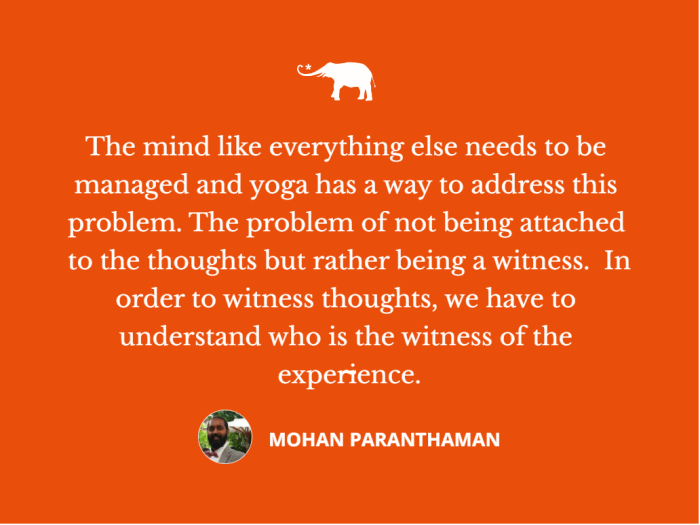
The monkey mind
Mann is the word used in Hindi/Sanskrit/Urdu to describe the mind. As per yoga, Mann is a collection of thoughts. These thoughts arise and are brought to the forefront of the consciousness based on the experiences of the 5 senses, resulting in sensory experiences. The five senses’ experiences are hearing, seeing, smelling, tasting, and feeling. Mere existence results in our sense organs being bombarded with experiences.
The eyes see the ocean, the ears hear the waves, the skin feels the wind, the nose smells the fishes in the fishing boat, and the tongue tasks the salty water. Each experience of sense results in thoughts. Now the thoughts are themselves harmless and serve a purpose. It’s the effect of the cause.
Hence, the mind wonders between one thought to the next based on our sensory experiences. The monkey mind is used to describe the nature of the mind. It’s a constant flux of thoughts and when we chase the thoughts and get recognized in them, we become the (monkey) mind.
Are thoughts really the problem?
The mind like everything else needs to be managed and yoga has a way to address this problem. The problem of not being attached to the thoughts but rather being a witness. In order to witness thoughts, we have to understand who is the witness of the experience.
Let’s take a step back, you are not your thoughts, you are not your mind, you are not your body. You are the witness of the thoughts, a witness of the experience. Thoughts cannot be stopped from arising, what we can control is not chasing the thoughts by becoming the witness.
Why become the witness?
The answer to this is a philosophical one and a choice we all have to make. It’s a lifestyle choice!
In the yogic tradition, a lot of emphases is laid on the power of the mind/Mann. The mind can make a great day feel bad and horrible without moving an inch of the body. The mind can also make us feel happy and content after a tumultuous day. The first step is to recognize the power the mind has on our day-to-day life.
Being a witness to the thoughts and just observing them rise and fall in the consciousnesses(through meditation and contemplation), reduces the influence of the mind on our actions.
Tools of the ancient yogis

This can be an article in self, the truth is that the thoughts cannot be stopped. At least not for an average yogi, dwelling in society. They need to be managed and reduced efficiently, every day. The beauty of yoga lies in its simplicity.
The big problems in life were studied and dissected to arrive at simple steps that can be used to address the root cause of the problems, the big existential questions with simple solutions like observing the mind, silence (Mouna), and breath work (pranayama). Anticlimactic with its simplicity, I would say, but an effective one nonetheless.
The ancients focused on understanding and applying these practices to their daily lives. Here are some tools you can use too.
- Pranayama, yogic breath work is the first tool in this context. This is also a practice(kriya) that can be done every day, as a daily self-management process. Many yogi’s start their day with pranayama(after asana). However, busy individuals can do 20-30 mins of daily pranayama practice. Making this a routine means a consistent lifelong relationship like brushing the teeth. If it’s impossible to allot 30 mins, while traveling for example, just do 5 conscious breaths in and out. consistency is not a competition. Being consistent is allowing 30 mins a day for self-practice.
- The right Asana practice with breath awareness is a great tool to establish a mind and body connection. The various postures mimic different ways to strengthen, loosen, expand and contract, both external and internal organs. Oxygenating with deep breaths and focused awareness distracts the mind from quietening. As the thoughts reduce, we feel refreshed and energized. Asana practice can be done in the morning or evening. Please exercise caution and get help from seasoned yogis or teachers while practicing yoga asana.
- Svadhyaya which means contemplation/Self-study in Sanskrit is the hardest practice yet it can also be the easiest practice. An example would be to witness the current state of mind and contemplate its nature of it. Are you feeling happy, sad, free, lonely, independent, etc., and contemplate the why. For example, you may feel happy to be on a holiday, with the freedom that comes with it. Your sense organs are experiencing what they want and hence your thoughts are of a happy nature. The idea is to understand the reason behind the reasons. Like peeling off layers of onions till nothing remains or the only thing that remains is you.
- The fourth tool is devotion(Bhakti). Not the type of devotion, having blind faith in something or someone that you haven’t seen, heard, or experienced. That can be cathartic in a seeker’s journey if done blindly. Bakthi is a path in yoga, usually associated with having loving devotion toward the higher consciousness. In the modern world, listening to other yogis talk about their experiences through spiritual gatherings(Satsang) is a great starting point.
There are other ways to quieten the mind too. Like exercising, jogging, bouldering, hiking, etc. These are means of refreshing the mind and the body temporarily. Long-lasting benefits can only be achieved with Yoga and meditation under the guidance of a seasoned guru or master, one is bound to find the gems of truth. The truth of our true nature is one of divinity, peace, and bliss. The truth that is with us now and in every moment.
Struggling to build a yoga routine?
We know that the concepts of yoga, especially traditional yoga(nonpopular yoga) are not easy to grasp even for seasoned practitioners. Knowledgeable yoga teachers are rare, even in the heart of yoga in India, finding an authentic yoga teacher is like finding a ruby in the rubble of bricks.
Asanaguru yoga has a mission of connecting the world with the best and most authentic yoga teachers, who can help you build a plan and set a consistent routine. We can help you can track your progress with a personal yoga teacher. The teachers will help you with a yoga plan and private classes to guide you and help you build a self-practice.
Reach out to [email protected] for information.







Read 0 comments and reply